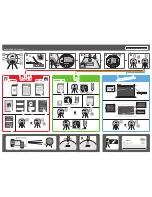
33
Imagine heating a gallon of water to 80
o
C in a 5 quart pan on an electric range. Placing the pan on
the range and turning the heat to ‘high’ you’d observe a delay in heating while the range coil warmed-up.
This delay might be a little annoying, but it's really no problem. The real problem comes as the water
temperature approaches 80
o
C. If you turned the range off just as the water reached 80
o
C the temperature
would continue to rise – even though all power had been disconnected – until the range coil cooled down.
This problem of overshooting the set point during initial warm-up is the major difficulty with process
controllers. Overshooting the set point is minimized in two ways by your J-KEM controller – but first let's
finish the range analogy. If you had turned the range off just as the water temperature reached 80
o
C, the
final temperature probably would not exceed 82
o
C by the time the range coil cooled down, because the
volume of water is so large. In most situations a 2
o
C overshoot is acceptable. But what if you were heating
3 tablespoons (45 mL) of water and turned the stove off just as the temperature reached 80
o
C. In this case,
the final temperature would probably approach 100
o
C before the range cooled down. A 20
o
C overshoot is
no longer acceptable. Unfortunately, this is the situation in most research heating applications. That is,
small volumes (< 2 L) heated by very high efficiency heating mantles that contain large amounts of heat even
after the power is turned off.
Your controller handles the problem of ‘latent heat’ in the heating mantle in two ways:
1)
The controller measures the rate of temperature rise during the initial stages of heating. It then uses
this information to determine the temperature at which heating should be stopped to avoid exceeding
the set point. Using the range analogy, this might mean turning the power off when the water
temperature reached 60
o
C and allowing the latent heat of the burner to raise the water temperature
from 60
o
to 80
o
C. This calculation is done by the controller and is independent of the operator.
The next feature of the controller is directly under operator control and has a major impact on the
amount of overshoot on initial warm-up.
2)
Again referring to the range analogy, you'd obtain better control when heating small volumes if the
range had more than two power settings; Off and High. J-KEM’s patented output power level (5 &
13) serves just this function. It allows the researcher to reduce the power of the controller depending
on the amount of heat needed. This circuit can be thought of as determining whether the heating
power is
Very low
(
1-10 mL
),
Low
(10-100 mL)
,
Intermediate
(50-500 mL)
,
Medium
(300 mL-2
L)
, or
High
(> 2 L)
. The proper power setting becomes instinctive after you've used your controller
for awhile. For additional information see Section 3.6.
4.2
Controlling a Heating Mantle Temperature Directly.
In a
normal
heating setup, the thermocouple is
placed in the solution being heated. The controller then regulates the temperature of the solution directly.
The thermocouple could alternately be placed between the heating mantle and the flask so that the controller
regulates the temperature of the heating mantle directly, which indirectly regulates the temperature of the
solution.
Advantages to this method include:
1. The temperature of any volume (microliters to liters) can be controlled.
2. Temperature control is independent of the properties of the material being heated (e.g., viscosity,
solid, liquid, etc.).
3. Air and water sensitive reactions can be more effectively sealed from the atmosphere.
The temperature meter must be programmed for use with an external thermocouple before this procedure is
used (see following procedure). The following step-by-step procedure programs the controller to regulate
heating mantle temperature. If you switch back and use the controller with the thermocouple in solution,
Содержание Gemini-230
Страница 1: ...Temperature Control For Research and Industry Model Gemini 230 Manual For Serial Number...
Страница 2: ...2...
Страница 5: ...5...
Страница 16: ...16 have the same color plug as the input 9 on the controller...













































